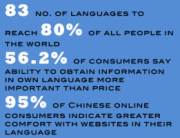In the age of the 21st century we now have access to state-of the-art Machine Translation (MT) via a number of search engine providers such as Google, Microsoft, Baidu and application providers such as Systran. Earlier this year Google even introduced a number of enhancements to its translate service so that a user is able to transcribe and translate audio content. But how does it stack up when compared to a human translator? The simple answer is there is a place for both. Machine translation is ideal for gaining a quick idea or “the gist” of a piece of written content, certainly enough for basic understanding. However it still struggles with context, nuance and offers poor word choices that can harm readability.
On the other hand human translation will not only get the direct translation correct but will ensure that the right context, cultural nuance and overall meaning is perfectly captured and applied. MT is best employed for international travel, skimming non-English websites, sorting of very large volumes of content, and everyday conversations with overseas relatives or friends. Whereas human translation should be used where 100% clear and accurate meaning is needed such as legal, financial or medical content or advertising and public facing content such as websites, brochures, PR news releases and other public facing material.
For more information please contact James Cook at james@gbinterp.com






